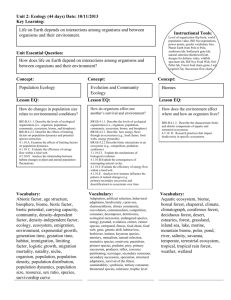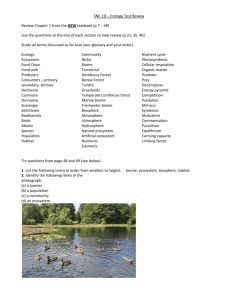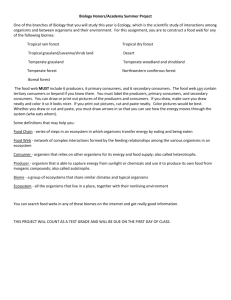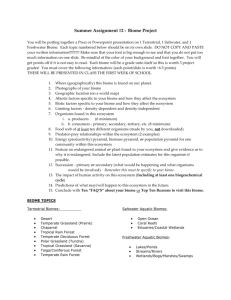Unit 7 Vocabulary Flashcards
advertisement
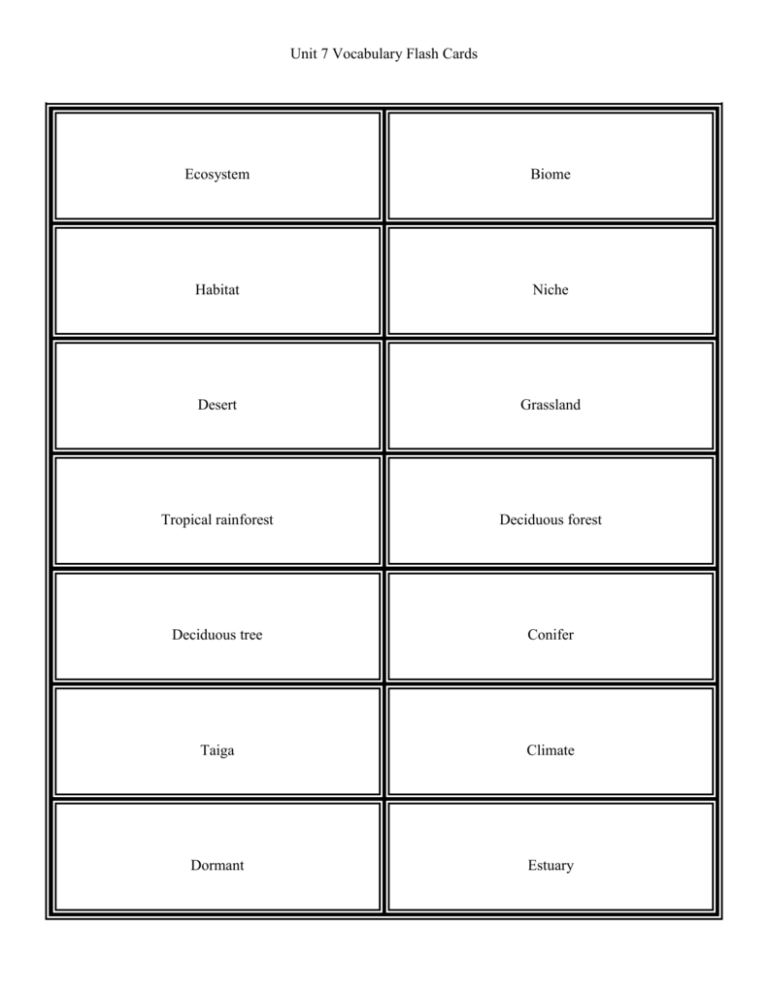
Unit 7 Vocabulary Flash Cards Ecosystem Biome Habitat Niche Desert Grassland Tropical rainforest Deciduous forest Deciduous tree Conifer Taiga Climate Dormant Estuary Large region or area that has the same climate and communities of species (plants & animals); ex: tropical rainforest, grassland, desert, ocean Role a population plays in the ecosystem; how it gets food, interacts with others; ex: predator, competitor, producer, herbivore A community of organisms and their nonliving environment; all the biotic and abiotic in an area; all the living and nonliving things in an area; ex: ocean, field, pond, mountains, salt marsh Place where organisms usually live and provides their water, shelter, food, etc Biome that has wet and dry seasons; wet season near the equator is called the monsoon and wet season farther from the equator has blizzards; animal migrate to follow the water; tall grasses, large herds of animals, best soil for growing crops Biome that has very hot days and cool nights, very little precipitation, most plants store water and many animal estivate (sleep) during the day; no real seasons Biome that has 4 equal seasons – winter, spring, summer, & fall; moderate amount of rainfall, comes as snow in winter; land covered in tress that drop their leaves in the fall and go dormant until there is enough light in the spring; many animals hibernate or migrate Biome that has rain almost every day, constant temperature all year long and all day and night, very humid, close to the equator, area covered in very tall trees, animal adapted to life in trees, plants brightly colored Tree that is shaped similar to a triangle with needles for leaves; stay green all year round – evergreen; reproduces using seeds inside of cones Tree that lose it’s leaves during the fall and goes dormant during the long winter; done because there is not enough sunlight to do photosynthesis in the late fall through early spring months The main abiotic factors that characterize a biome; the long-term temperature patterns and the amount of precipitation in the region as well Means swamp forest, another name for the coniferous or boreal forest since the frozen ground thaws during the summer and becomes a swamp An ecosystem that is a mix of freshwater and salt water; ex: mouth of a river emptying into the ocean; bog, swamp The process where deciduous trees lose their leaves and shut down their systems for the long winter months, done to conserve water since there is not enough sunlight to do photosynthesis Coniferous or boreal forest Tundra Marine Freshwater Precipitation Nocturnal Diurnal Estuary Monsoon Canopy Permafrost wetland Energy Matter Biome that stays cold all year long and the ground is constantly frozen – called permafrost; very little precipitation, very long winter, animals have white fur and lots of body fat, many migrate Biome that is cold most of the year with a short time that is gets mild in the summer, long winters, most of the precipitations falls as snow; animals change fur color in winter; trees are triangular shaped to keep snow off and makes cones, needles for leaves, evergreens Biome that has no salt in the water, the water can be still or moving, animals come into contact with humans, plants grow all over; ex: stream, pond, lake Biome known as the ocean; has salt water and can get very deep so sunlight does not reach all the way to the bottom; tides and current move the water around; lots of big animals and plants live at the top of this biome to get the sunlight available Animals that are awake and active during the night and spend their days sleeping; done since fewer predators are out at night Part of the water cycle where water falls from the clouds in the form of rain, snow, sleet, hair, freezing rain, etc An ecosystem that is a mix of fresh and salt water; acts as a nursery for baby animals to be born in and grow up Animals that are awake and active during the day and spend their nights sleeping Upper level of a tropical rainforest where all the leaves of the trees overlap; where most of the animals live Large rainstorm that happens in tropical grasslands where it rains very hard for many days in a row causing major floods Area of land that is covered in water all or part of the year; ex: bog, marsh, swamp Permanently frozen ground or soil in the tundra; stays frozen all year long with only the top few inches thawing out in the summer Anything that has mass and takes up spaces Ability to do work and allows organisms to use matter in life process and survive Law of conservation of energy Law of conservation of mass Energy pyramid Water cycle Nitrogen cycle Carbon cycle Producer Primary consumer Secondary consumer Tertiary consumer Precipitation Condensation Transpiration Evaporation Law that says that matter isn’t created or destroyed, it just changes form; ex: ice melts into liquid water; sodium and chlorine combine to form sodium chloride (table salt) Law that says energy isn’t created or destroyed, it just changes form; ex: plants change the sun’s energy into glucose (chemical energy) The movement of water between oceans, the atmosphere, land, and living things; precipitation, condensation, evaporation, and transpiration Chart used to show the flow of energy through an ecosystem; there is less energy as you move through the ecosystem as organisms are use up the energy to live The process where carbon moves between the environment and living organisms through photosynthesis, cellular respiration, and other processes The process where nitrogen is moving between the environment and living things; nitrogen in the atmosphere is turned into fertilizer by bacteria and decomposer bacteria break down dead organisms and waste and release nitrogen back into the air The first consumer to eat the producer, an herbivore; gets 10% of the producer’s energy Organisms, like plants, that make their own food and are found at the beginning of the food chain or energy pyramid; the plants transforms sun’s energy into chemical energy and make a sugar called glucose The third consumer in a food chain or energy pyramid, it eats an animal; gets 0.1% of the animal’s energy The second consumer in a food chain or energy pyramid, it eats an animal; gets 1% of the animal’s energy The process where water vapor (gas) changes into liquid water droplets; in the water cycle it forms a cloud in the sky The process where water falls from the sky to the land in the form of a liquid (rain) or a solid (snow, sleet, hail, freezing rain) The process where liquid water in ponds, streams, river, oceans, etc are heated up and turned into water vapor (gas) that goes up into the atmosphere The process where liquid water in plants are released from the leaves and turned into water vapor (gas) that goes up into the atmosphere Photosynthesis Cellular respiration Fossil fuels Combustion Decomposition Greenhouse effect Eutrophication Succession Primary succession Secondary succession Pioneer species Climax community Catastrophic disturbance Biodiversity The process where animals or plants use oxygen to break down glucose to make carbon dioxide, water, and ATP (energy) The process where producers take carbon dioxide, water, and sunlight and turn it into glucose and oxygen The process of burning materials, including fossil fuels and wood to create heat and release carbon dioxide into the atmosphere Type of fuel formed by decomposing organisms that were buried in the ground millions of years ago; releases carbon dioxide into the air when it is burned in combustion; ex: coal, oil, gasoline, natural gas The process where greenhouse gases, like carbon dioxide, build up in the atmosphere and trap the sun’s energy and heat up the planet The process of breaking down dead organisms and waste and returning the elements and nutrients to the environment through the nitrogen cycle The slow change in an ecosystem from one form to another, like a pond filling in and becoming a field, or plants growing back in a forest after a forest fire The process where nutrients, like animal poop and fertilizers, build up in water over time; leads to algal blooms and dead zones The process where an existing ecosystem goes through changes and still has its soil; it changes from one ecosystem to another, like a deciduous forest becoming a boreal forest, or it grows back after a catastrophic disaster like a volcanic eruption, forest fire, land slide, hurricane, etc The process where plants start to grow on rock, where the is no soil; this could be caused by a new volcanic island forming or a glacier melting after thousands of year, pioneer species need to create the soil first before larger plants can grow there; it takes millions of year An ecosystem that has been stable for many hundreds of years and all the plants have grown as tall as they are going to get; ex: deciduous or boreal forest that has been undisturbed for several hundred years The first organisms to live in an uninhabited area and start to turn the rock in to soil; ex: lichens, mosses The number and variety of species that live in an area; the tropical rainforest has the greatest number of different plants and animals so it has the largest biodiversity of life A natural disaster that destroys or damages part or all of an ecosystem; ex: forest fire, avalanche, blizzard, flood, mudslide, hurricane, tornado, tsunami, rock slide, etc Urbanization / urban sprawl Habitat fragmentation Erosion Pollution Stewardship Conservation Endangered species Extinct species Invasive species Exotic species Overfishing Deforestation Reforestation Habitat destruction The cutting a habitat in half and making it hard an animal to get from one side to another; ex: putting a road in the middle of a forest; building a housing community in the middle of a grassland The growth of cities out into the land around them; also known as urban sprawl Any unwanted change in the environment caused by substances (like litter, waste, carbon dioxide) or forms of energy (like heat, light) The process where soil is carried away by wind or water The protection and wise use of natural resources; ex: using fewer natural resources, reducing waste, recycling The careful and responsible management of a resource A species that has no more living members on Earth, they have all died off, like the dinosaurs A species that has very few members left on Earth, it can become extinct very easily A species that is not native to an area, it has be introduced, or brought in from another ecosystem A species of plant or animal that is introduced to an ecosystem and takes it over, it out competes the native species for resources and kills them; ex: kudzu in the southern US The process of cutting down a forest or most of the forest in an area The process of destroying a habitat through human use; ex: building houses, malls, roads, cities, cutting down all the trees in the forest, open pit mining, etc The process of taking more fish out of the water than nature can replace; can lead to the species becoming endangered or extinct The process of replanting all or most of a forest

